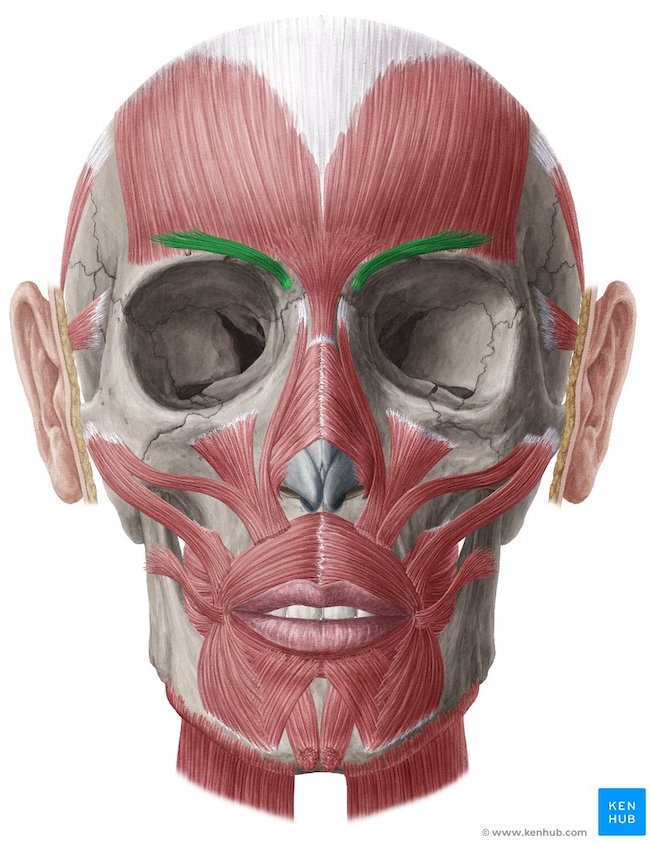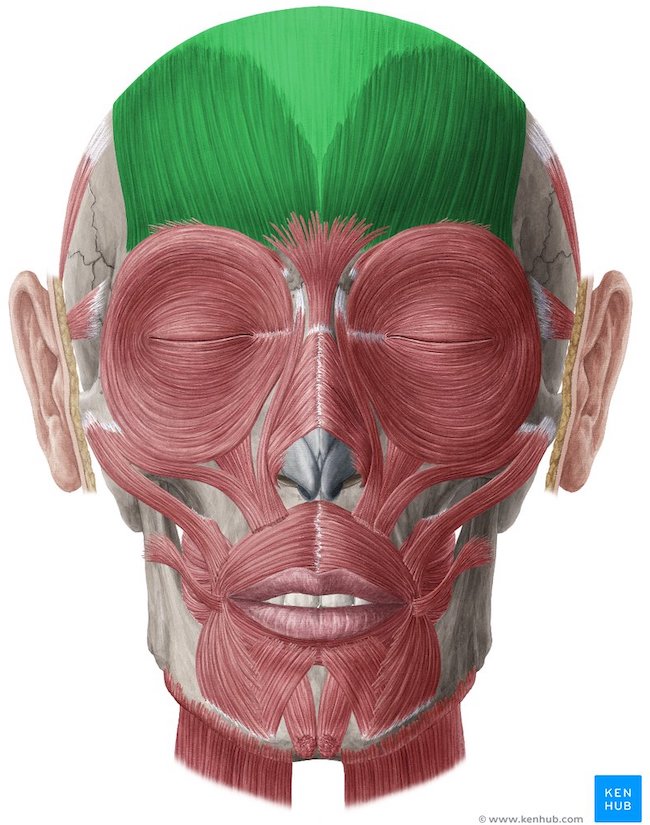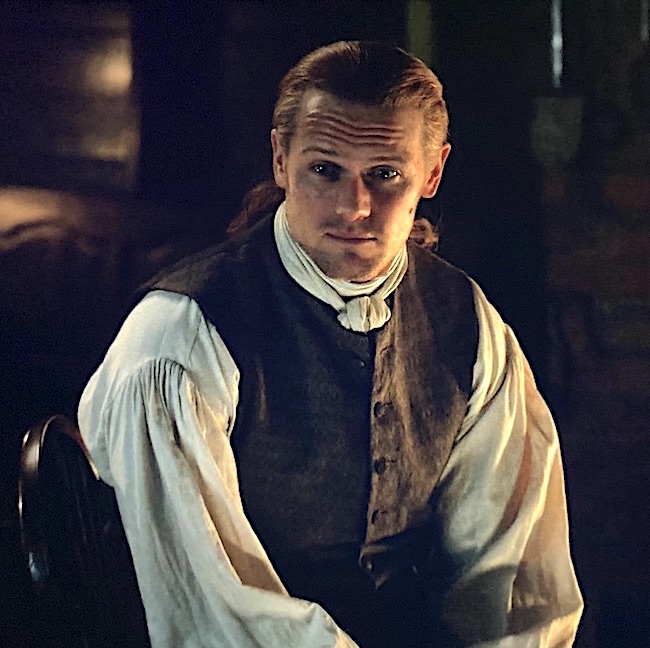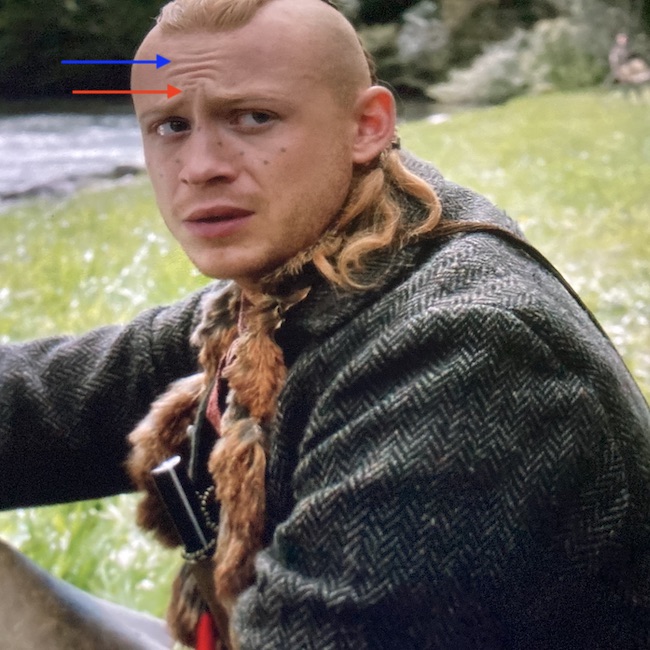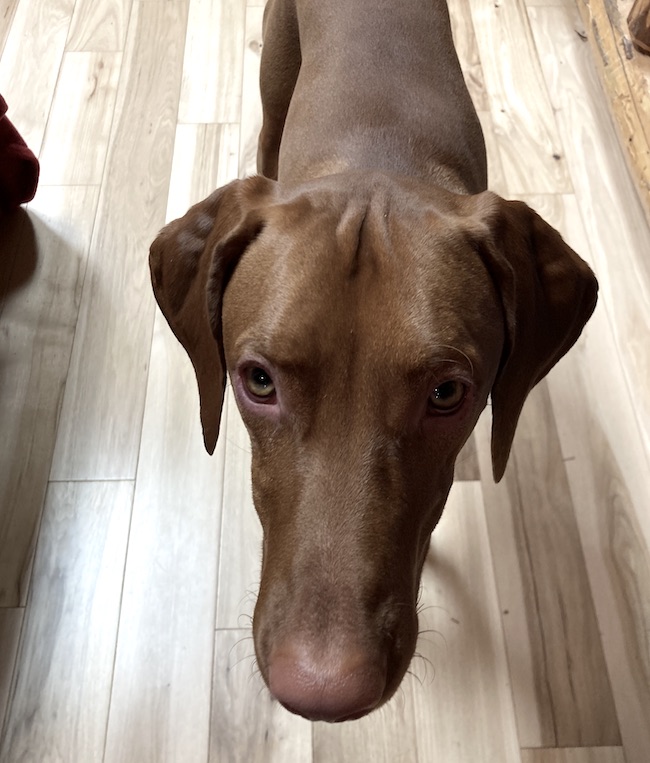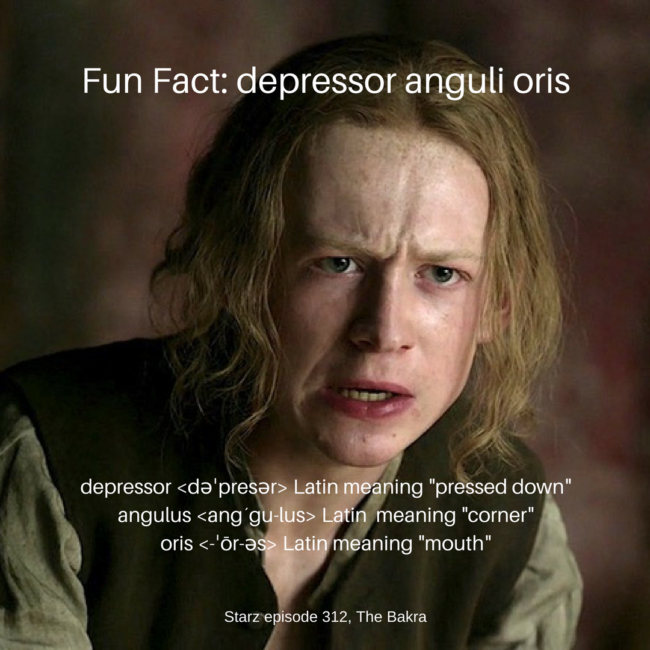We humans communicate via written word, oral articulation, body language and facial expression.
Welcome to Anatomy Lesson #11 where we learn about muscles that give expression ta the face; it telegraphs more emotional content than perhaps any other body part (Image A) and it’s probably the main way the world recognizes each of us.
WARNING: if ye are a wee bit squeamish, this post contains drawings of the skull and facial muscles sans skin. But, if you concentrate on the science queasiness is usually replaced by the intellectual challenge of learning. I promise. Be brave!
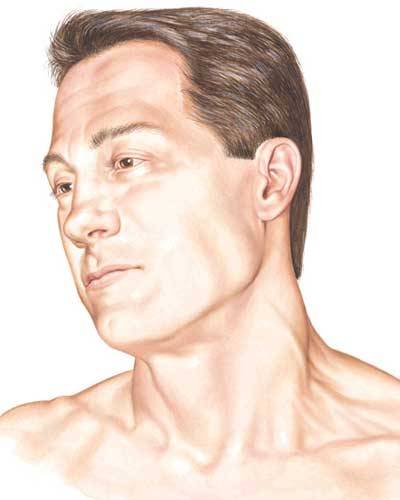
Image A
This lesson starts and ends with Jamie. Why? Can you name an actor with a more expressive face? Frankly (no, not that Frank), I think our ruadh Jamie ranks up there with expressives such as Sir Anthony Hopkins and Sir Laurence Olivier. His range of facial expression is so great that there are times he looks like a different actor! Check the next image: at first glance, his gorgeous countenance appears serene but look again: it fair beams wi’ intelligence, determination, calculation and wit (Starz episode 4, The Gathering)!
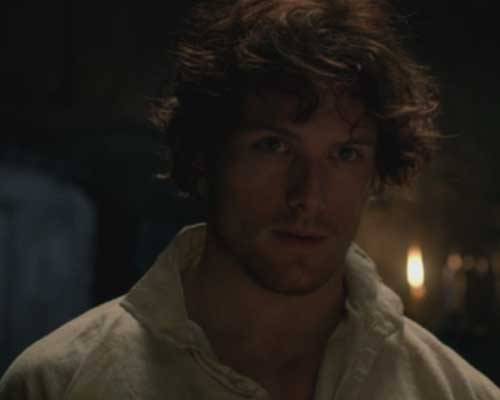
And, I’ll be saying that Jamie is no afraid to use his muscles of facial expression if they yield keener insight into his emotional state – here as the warrior furiously fighting the Grants (Starz episode 8, Both Sides Now).
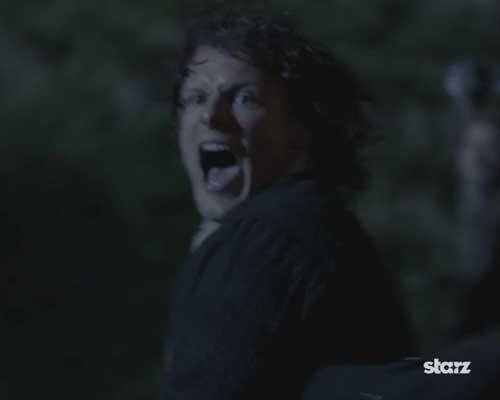
OK – on to the lesson!
Skull: Several skull bones provide attachments for muscles of facial expression (Image B). Please palpate (feel) these on your own skull: the bone of your forehead is the unpaired frontal bone; at the back of the skull is the unpaired occipital bone; the cheeks are mostly the paired zygomatic bones (Anatomy Lesson 8); the upper teeth are seated in paired maxillary bones; the lower teeth anchored into the unpaired mandible; the bridge of the nose is formed by paired nasal bones.
Try this: Grip the bridge of your nose wiggle it – normally, it doesn’t move. Now, work your fingers toward the tip until you feel bone give way to soft tissue – at this point the nasal bones are joined to nasal cartilages which you can easily wiggle.
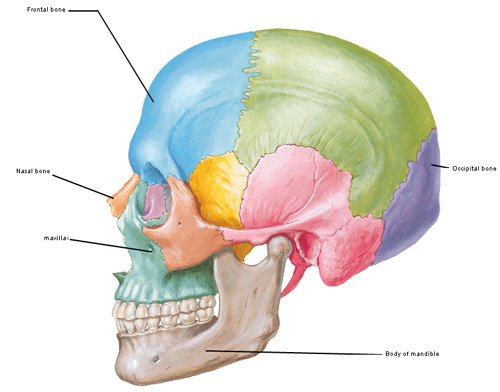
Image B
The human face has 20+ pair of muscles of facial expression (Image C – not all muscles are shown). Little wonder that the face can display an astonishing range of emotion with more than 40 individual muscles plus working individually or in groups for combined effects!
Facial muscles vary considerably from person to person. Most are thin, flat and subcutaneous (just under the skin). Some attach to skull bones, or to the dermis of the skin (Anatomy Lesson 5 & Anatomy Lesson 6) or with other facial muscles. Thus, some have no bony attachments at all. As these muscles contract, the skin wrinkles at right angles to the direction of the muscles fibers, which over time gives rise to wrinkles. They also have strange names that are pronounced like they are spelled.
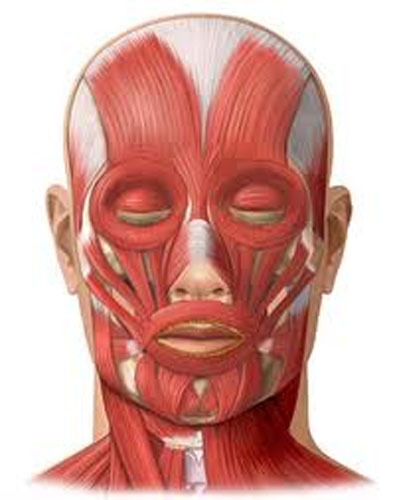
Image C
The muscles of facial expression develop from the same embryonic region and all are innervated by the paired facial nerves which arise from the brain (Image D).
Each facial nerve leaves the skull via a hole (foramen) just below the ear canal and breaks into 5 branches that supply the muscles of facial expression. (psst…The large bumpy orange mass at the side of the face is the right parotid (salivary) gland).
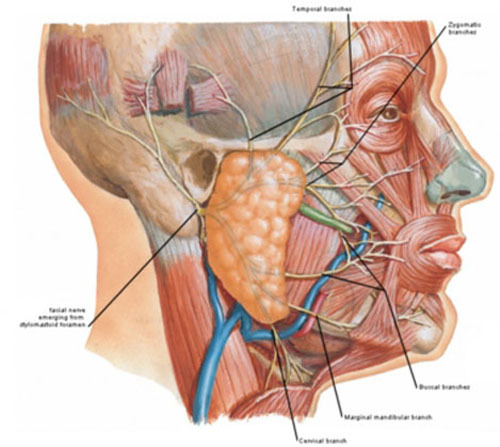
Image D
We anatomists love using devices and mnemonics to help us remember the myriad of names and details of the human body. It’s a mess of info you ken? Here is a fun one to recall the branches of the facial nerve (Image E); it’s a teaching device – not intended to intimidate the wee lassie. I like this acronym to recall the branches: To Zanzibar By Motor Car!
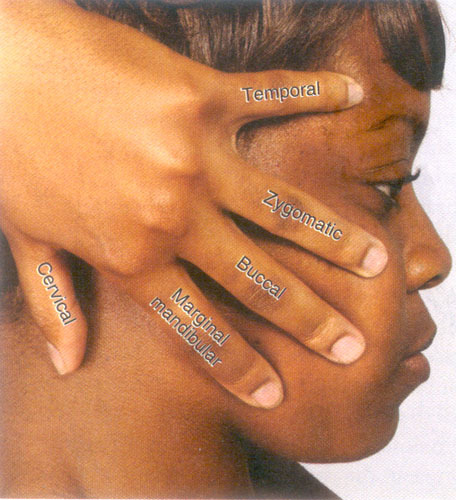
Image E
The paired facial nerves signal the muscles of facial expression to contract! If a facial nerve is compromised by injury, etc., then the facial muscles are paralyzed on the same side. This condition, known as Bell’s palsy, is demonstrated in the archival photo of a gentleman from the late 1800s (Image F). The right side of his face (on your left) has lost expression: he cannot close the eyelid, his mouth droops and his smile (nasolabial) fold is flattened.
Bell’s palsy is a difficult, debilitating and depressing condition because, as noted earlier, our face is how we face the world. To honor contributions by Scots to medical science (there are many) the syndrome bears the name of the man who first described it: Dr. Charles Bell (1774-1842) surgeon, anatomist and graduate of The University of Edinburgh. Pertinent to this topic and based on his anatomical knowledge, in 1806 Bell published “Essays on the Anatomy of Expression in Painting” for the instruction of artists.
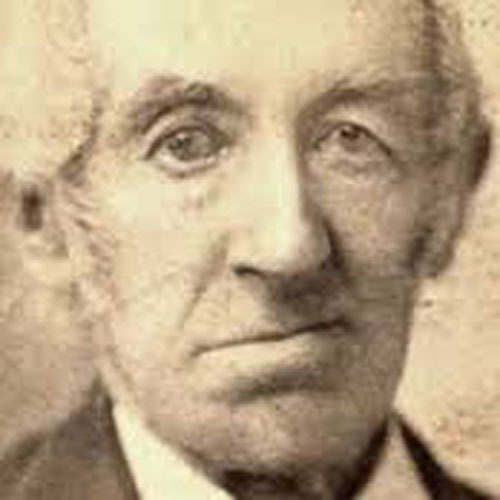
Image F
Back to the muscles of facial expression!
For simplicity, I divide the face into five regions, naming their facial muscles and providing examples from Outlander cast members. Please ken that I canna cover all the muscles of facial expression nor all the cast for such a post would be way toooo long.
Region #1 – Forehead/Eyebrows: Four paired muscles act in this region but we will discuss only three pairs (Image G):
-
- Frontalis (black arrow),
- Occipitalis (blue arrow) and
- Corrugator supercilii (purple arrow)
NOTE: Skin overlying the corrugator supercilii (purple arrow) receives it own name, glabella, meaning smooth. At rest, the skin between the eyebrows is smooth unless the corrugator contracts and then it wrinkles.
Frontalis: Fibers of the frontalis muscles are oriented vertically from a connective tissue sheet overlying the skull (galea aponeurotica – grey in Image G) to the dermis o’ the eyebrows. Frontalis muscles raise the eyebrows and wrinkle the skin of the forehead as in asking a question or expressing concern.
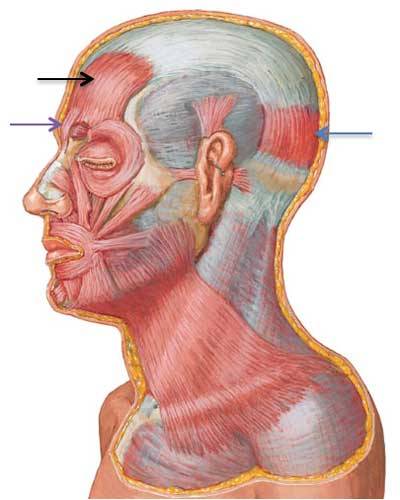
Image G
Now, several of you have begged for Dougal in a lesson. So, here he is with both frontalis muscles contracted as he interrogates Claire (Starz episode 5, Rent).
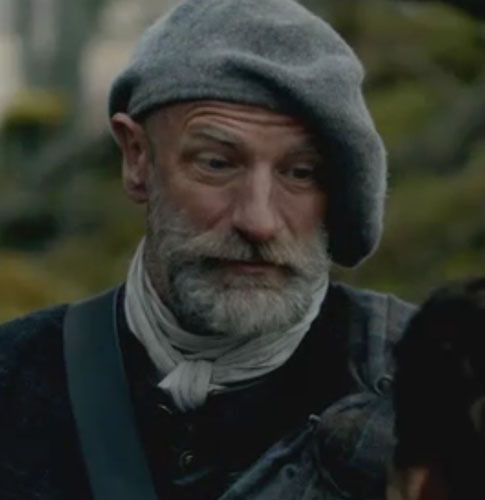
Occipitalis: The paired occipitalis muscles (Image G 🤞🏻) are oriented vertically from the occipital bone to the galea aponeurotica. When they contract, forehead skin is pulled backward.
As Claire causes kissus interruptus, Jamie contracts his occipitalis muscles and his forehead and scalp are pulled backward (Starz episode 7, The Wedding)! Watch the episode again (as if you need an excuse) to see his occipitalis muscles in action and you’ll ken what I mean.
Claire, what a tease! (psst…Jamie, if the lass willna do her duty, in the interest of science I’m sure there are plenty of others willing to step in…just sayin’!)
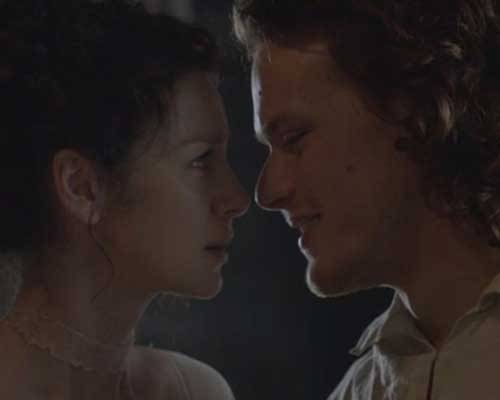
Corrugator supercili: Fibers of the paired corrugator supercilii are oriented diagonally from the frontal bone to the dermis between the eyebrows (Image G 🤞🏻). As they contract the brows “knit” together creating vertical wrinkles between the eyebrows as in worry, frown or puzzlement. Here, Claire watches as Geordie nears death at the tynchal (Starz episode 4, The Gathering).
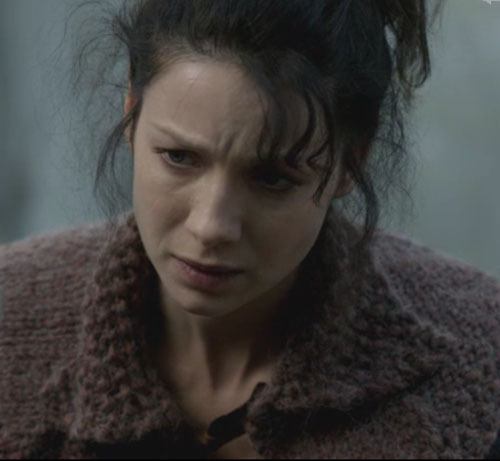
Q: Now, here’s a more complicated facial expression: Jamie watches a foul redcoat deserter assault Claire (Starz episode 8, Both Sides Now). Which muscles of his forehead are contracted?
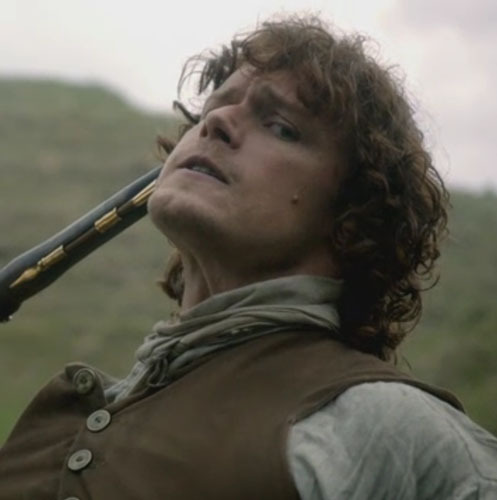
A: Well, turns out both frontalis and corrugator supercilli muscles contract to reflect terror, despair or helplessness. Jamie looks to be in agony here. Good job if you named either muscle!
Region #2, Eyelids: One pair of facial muscles operates the eyelids, the orbicularis oculi (Image H – black arrow).
Orbicularis oculi are paired elliptical muscles attaching to frontal and maxillary bones and to a fibrous band at the inner corner of each eyelid.
-
- Orbital loops of each orbicularis oculus rise to the brows, reach the temple and overlay the zygomatic bone.
- Palpebral loops extend into the upper and lower eyelids.
Contraction of orbicularis oculi close the eyelids to varying degrees. (NOTE: the eyelids are opened by muscles that do not belong to muscles of facial expression.)
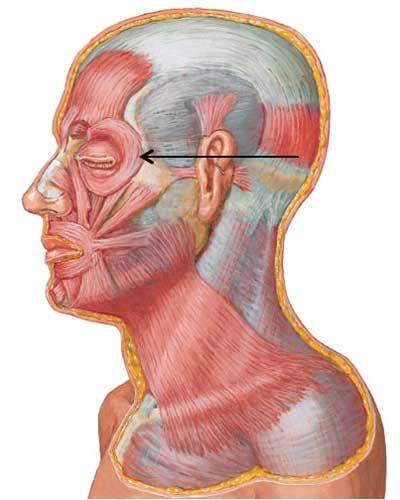
Image H
Here is a funny scene from Starz episode 5, Rent: Dougal is telling the Highlanders about auld granny Mary asking her husband what he was thinking “when ye first saw me nipples!”
Note the crow’s feet at the corner of his right eye (L not visible)? These are caused by contraction of each orbicularis oculus muscle – here in an expression of mirth. Dougal is so into his story that he drools! It happens quickly, but you can see a wee sliver of saliva after it drops from his mouth (red arrow). Verra funny!
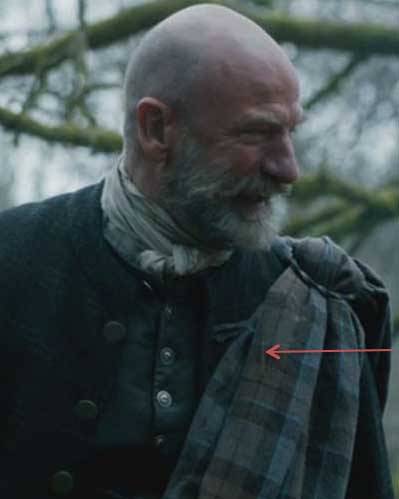
In the same episode Jamie tells Claire: “Dinna worry – trees are safe, Sassenach” (much safer than Uncle Dougal. Aye?).
Here only the orbicularis oculi of his lower eyelids are contracted giving him the Fraser cat’s eyes and broad cheekbones that Herself attributes to Jamie.
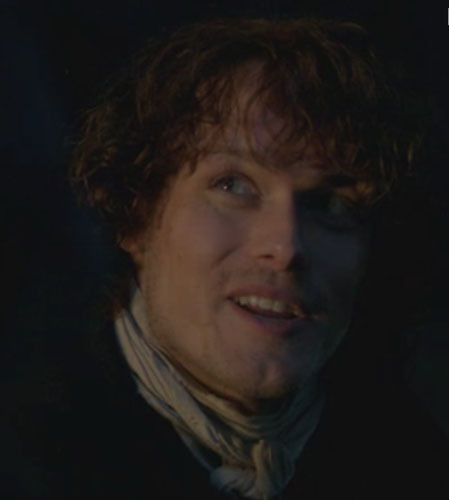
Here’s Claire’s with her eyelids closed because the palpebral parts of her orbicularis oculi muscles are fully contracted. She’s just told Jamie that his dirk is too long and heavy for her (Starz episode 8, Both Sides Now). Snort! Rupert replies that the lassies say that to him all the time so Claire gives him a look of mild disgust. Naughty Rupert!
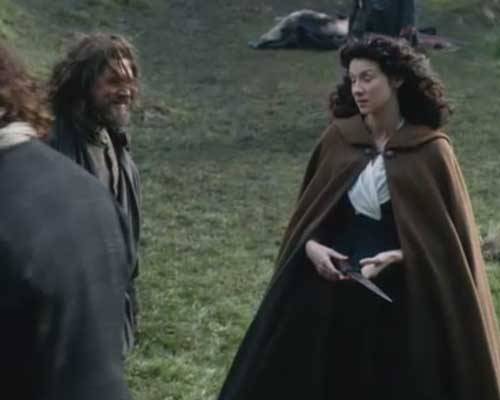
Region #3, Upper Lip: A whopping five pair of muscles operate the upper lip (Image I)! We’ll cover four of the pairs:
-
- zygomaticus major (purple arrow),
- levator labii superioris alaeque nasii (green arrow) and
- rizorius (blue arrow).
- orbicularis oris (black arrows) operates both upper and lower lips
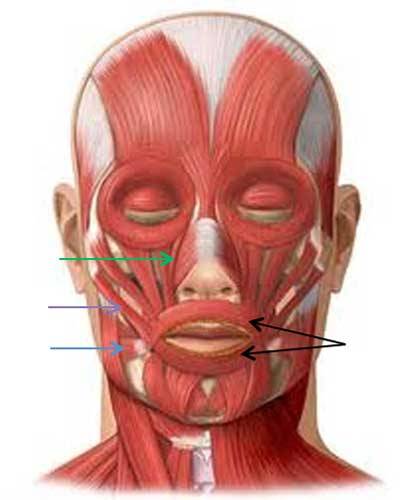
Image I
Zygomaticus major: Zygomaticus major reaches from the zygomatic bone to the corner of the lips. Its contraction pulls the corners upward as in a smile. Jamie shows a good one here (Starz episode 5, Rent).
Claire has just declared that Angus can “kiss her bloody English ass.” Jamie canna help but grin – she’s a spirited lass and he likes her potty mouth. Hey, hey, did you also ken that he has cheek dimples? Too cute!
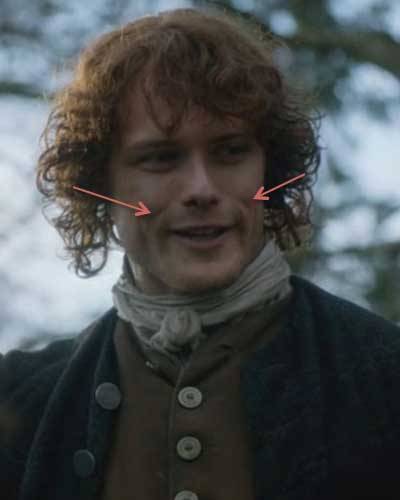
Levator labii superioris alaeque nasi (LLSAN): The LLSAN muscles have the longest name of the 600+ skeletal muscles of the human body but they are small. The name is Latin for “lifter o the upper lip and wing of the nose”.
Each muscle arises from the maxillary bone and divides into two slips – one to the upper lip and the other to a nostril. In plain English, the lip-slip lifts the lip into a snarl and has been tagged “The Elvis Muscle”. Well, Rupert beat Elvis out by two centuries when he snarls at Claire “Horse, my cock” (Starz episode 4, The Gathering)! Yep, that’s his right LLSAN muscle contracting.
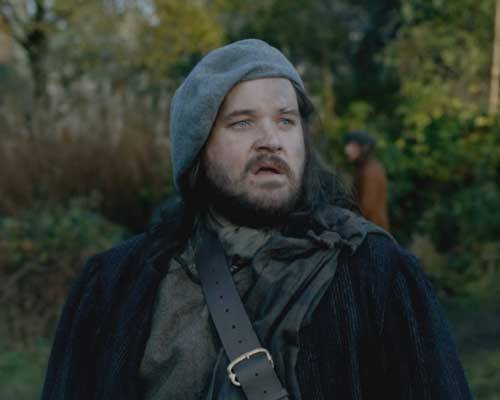
The other slip of LLSAN flares the nostril (red arrow). It’s quick but here Jamie flares his nostrils as he tells Claire he reckons they will be riding all that night and the next one too (Starz episode 1, Sassenach)! There is a better one of his flaring nostrils but I’ll be saving that for a later lesson!
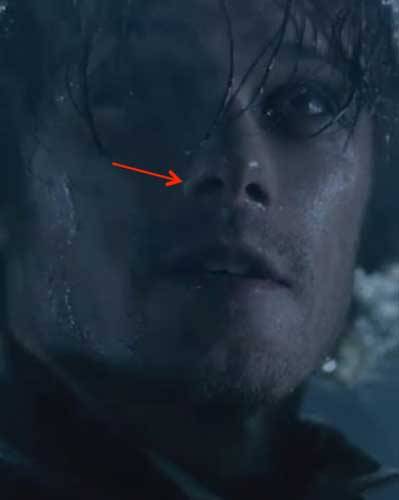
Risorius: Rizorius muscles reaches from the parotid glands (Image I 🤞🏻) to the corner of the lips. As they contract, the mouth pulls into a grim, flat smile – here, Jamie kens just how pissed Claire is about the marriage contract (Starz episode 6, The Garrison Commander)!
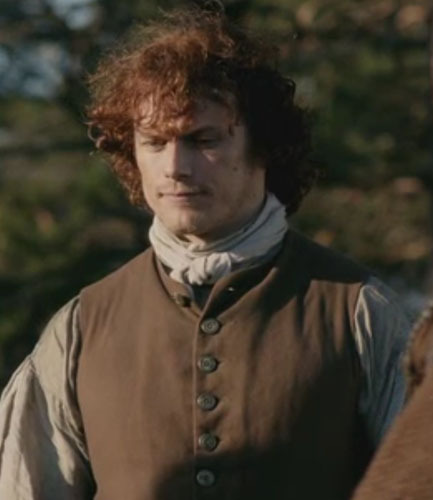
Orbicularis oris: Orbicularis oris circles the mouth but isn’t a sphincter; it is a complex of four interlacing quadrants of muscle that contract to:
- Close the mouth
- Pucker the lips
- kiss
- Play brass instruments
- Spit
See it in action here as Jamie warns Claire that he will brook no dissent from her – aye, she is coming with him (Starz episode 1, Sassenach)! If she willna walk then he will pick her up and throw her over his shoulder! Does she want him to do that? Her mouth says no, but her heart says, oh aye!
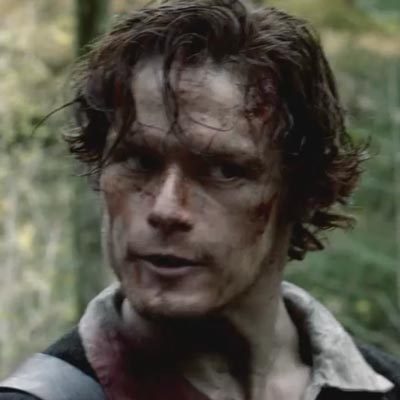
And here is Claire’s orbicularis oris muscle getting into the act as she puckers up and spits in the face of BJR (Starz episode 1,Sassenach)! Doesna matter if he does look like Frank, the smart lass wants nothing to do with this bloody bastard!

Region #4, Lower Lip: The lower lip has 5 paired muscles that activate it. The lower lip is also moved by the unpaired orbicularis oris but it has already been discussed above 🤞🏻. We will cover four (Images J & K):
-
- mentalis (green)
- depressor anguli oris (purple arrow)
- platysma (blue arrows)
- depressor labii inferioris (see Image K)
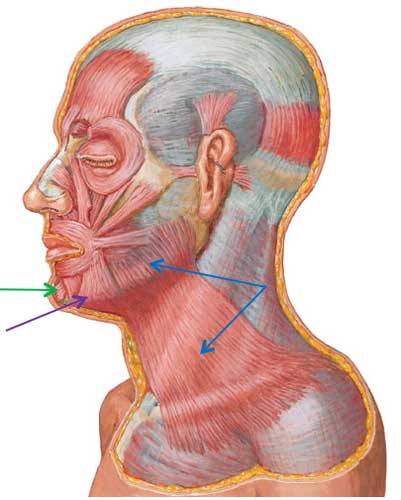
Image J
Mentalis: Mentalis muscles contract to pucker the chin skin. See Mrs. Fitz (red arrow) asking God to bless Claire for saving her nephew, Tammas Baxter (Starz episode 3, The Way Out).
Just so you understand, the lips are everted by other muscles. Mrs. Fitz adores Claire. She would have the Miracle Worker sit for a portrait if it were up to her!
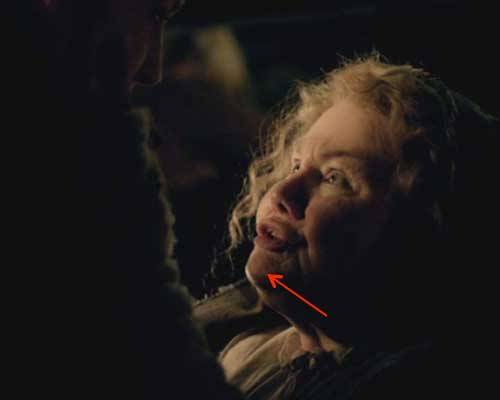
Depressor anguli oris: Depressor anguli oris muscles pass from the mandible to the orbicularis oris muscle (Image J). As they contract, the lower lip is drawn down; Claire contracts both of hers to demonstrate disgust at the British treatment of the Scots (Starz episode 6, The Garrison Commander). Her outspoken words place her in the hands of BJR!
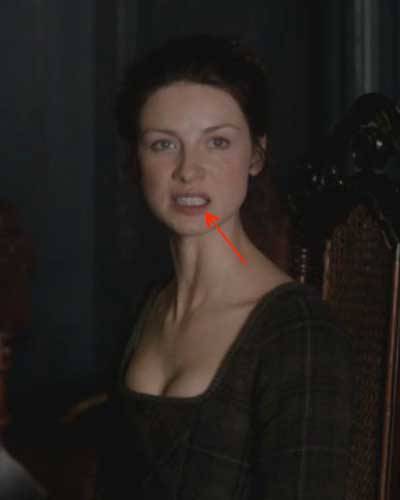
Platysma: Each platysma is a long, thin flat muscle that begins in the dermis near the 2nd rib, passes over the jaw and ends in the dermis near the lower lip; it has no bony connections and is sometimes listed as a muscle o’ the neck (Photo J).
Have ye noticed how a horse can quiver its skin to rid itself of flies? It has a pair of muscle equivalent to the human platysma. As our platysmas contract, they pull down the lower lips and wrinkle the skin of the neck conveying the expression of a grimace.
Here we see Jamie with his platysmas contracted (red arrows) after he hoists Dougal over his shoulder because his uncle was playing dirty shinty (Starz episode 4, The Gathering)!
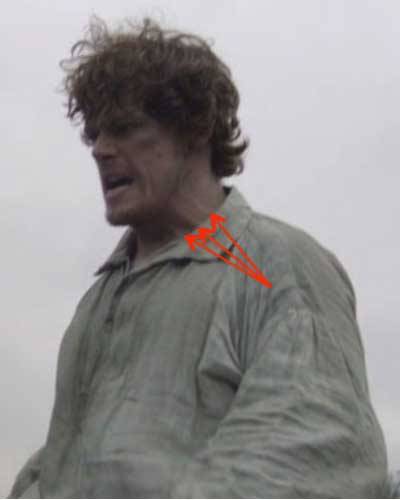
- Depressor labii inferioris: The fifth and last pair of lower lip muscles is depressor labii superioris, green in Image K. This muscle extends from mandible to dermis of lower lip. As its name implies, it pulls down on the lower lip. Couldn’t find a good Outlander example so the drawing must do.
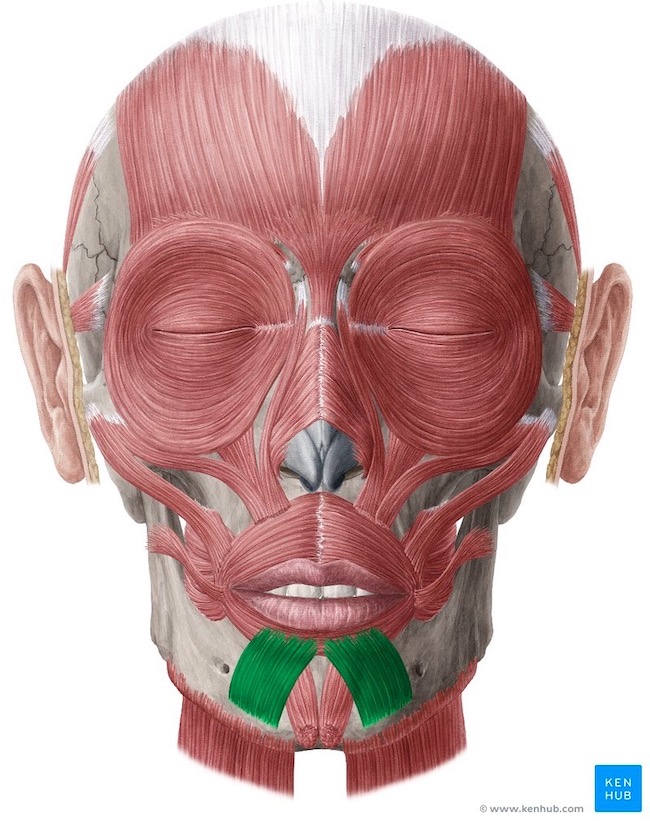
Image K
Region #5, Cheek: Each facial cheek contains one muscle, the buccinator (Photo L – black arrows); it hides deep to risorius muscles. Each muscle starts near the back of the jaw and blends wi’ the orbicularis oris. It’s known as the bugler’s muscle fer guid reason; try this, fill yer mouth wi’ air and push out yer cheeks. The bulging cheeks contain the buccinators. Now, draw yer cheeks inward ta blow out the air; ye just contracted yer buccinators. Congrats!
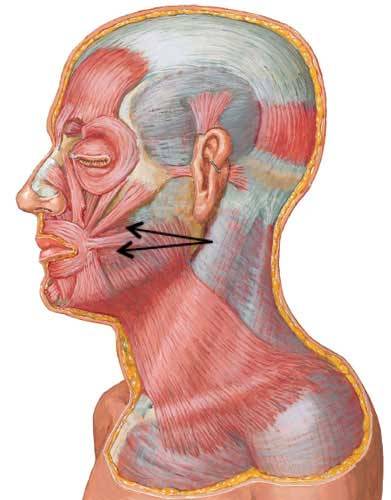
Image L
Here, Jamie’s right buccinator (green arrow – canna see the left one) is expanded as he contemplates one of a bazillion questions thrown at him.
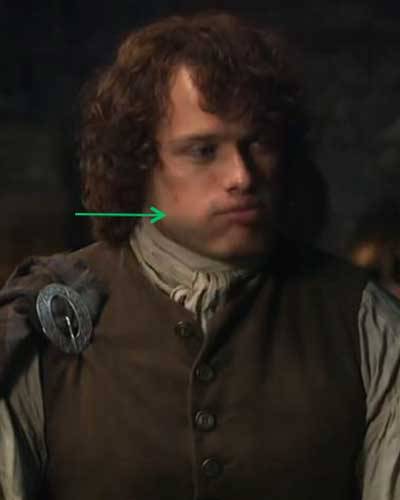
That brings our lesson on the muscles of facial expression to a close.
but, here is something to contemplate…. in case you think that animals cannot have facial expression take a wee keek at these next four images (Starz episode 5, Rent).
In this scene, Rupert has just told the Highlanders how he was stuck between hairlip Chrissie and sweaty Nettie trying to decide which one to swive first. Sassy-lassie Claire declares that she believes his left hand is jealous of his right! This brazen comment is followed by a moment of tension where everyone, especially Jamie, awaits Rupert’s Response (sounds like the title of a book – Aye?). Jamie gets the joke right away.
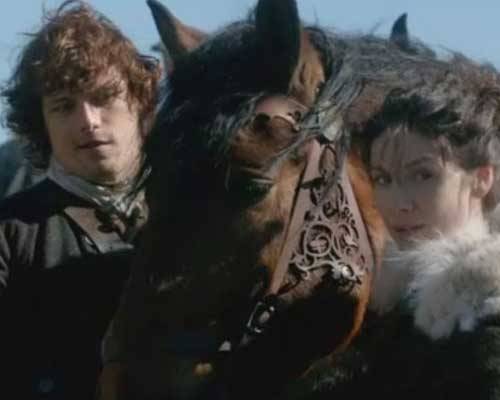
Takes a few seconds but then the other Highlanders get her joke! Jamie’s zygomatic majors are contracted here in a big old grin! Then, Brimstone gets the joke!
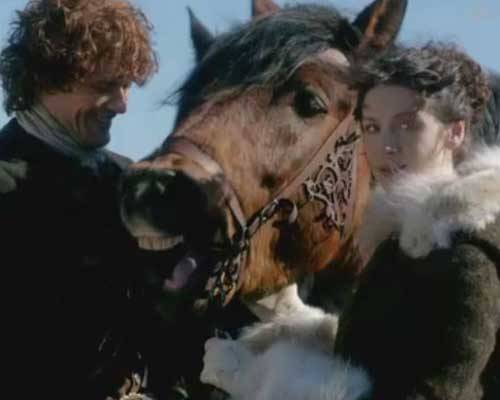
Brimstone is really getting into it along with Jamie!
BTW did you notice the beautiful cutwork on Brimstone’s bridle? Dinna know who did the leather work but it’s almost as lovely as Claire’s wardrobe which Mrs. Fitz puts together sometime between supper after the boar hunt and first light the next day as they head off to collect the rents! (That Mrs. Fitz sure is a miracle worker herself). I figure the covered wagon they take is to carry Claire’s wardrobe – it would put a queen to shame!
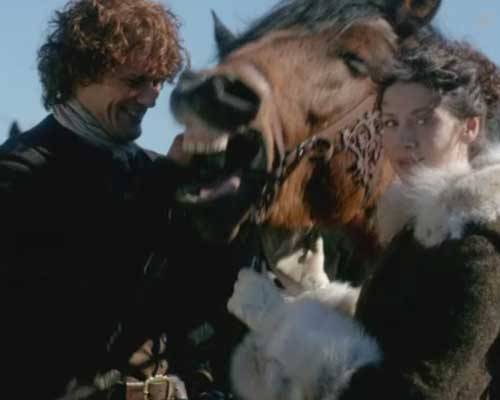
And finally, the full horse laugh from Brimstone. Och, ye are a witty one, Claire!
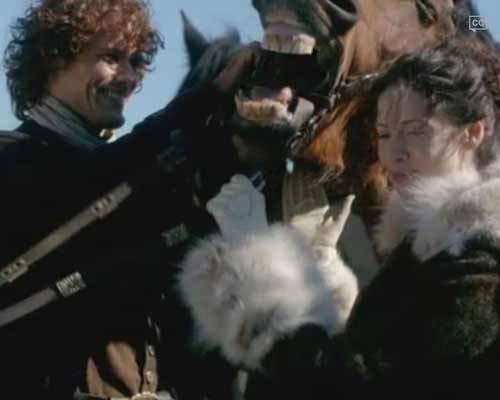
Now I promised you that I would begin and end with Jamie. I have pondered how it is that he has such an expressive face. Here are my ideas:
- He has more muscles of facial expression than most folk! Aye, it happens and I have seen examples in the dissection lab.
- His facial muscles are more highly innervated giving greater control over them.
- He is a keen observer of human emotional nuance and highly intuitive which allows him to feel his way through a character more than most actors.
- His emotional intelligence derives from some combination of the above.
Whatever the explanation, we viewers are the lucky beneficiaries of his acting skills. So, thank ye Jamie!
Here’s a terrific example from Starz episode 3, The Way Out as Claire unties Jamie’s stock to check his gunshot wound: with little more than sideward glance, a slight narrowing of the eyelids and a wee tug of the lips, Jamie conveys extreme discomfort and smoldering UST! Och, if ye dinna know what it means, check www.urbandictionary.com!
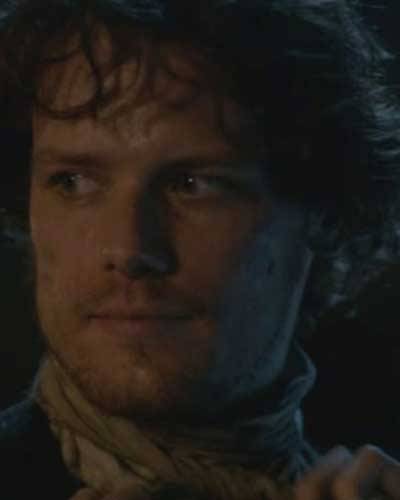
I hope ye enjoyed learning about the verra important muscles of facial expression, especially Jamie’s!
And for those who are new to my blog, a note of explanation: I follow the convention of using character’s names rather than actor’s names. This gives the cast at least one degree of separation and a wee modicum of respect as I dissect their bodies with words! I hope you all understand!
The deeply grateful,
Outlander Anatomist
Follow me on:
Image credits: Sony/Starz, Netter’s Atlas of Human Anatomy, 4th ed., Clinically Oriented Anatomy, 5th ed., Hollingshead’s Textbook of Anatomy, 5th ed., www.kenhub.com, www.Wikipedia.org

